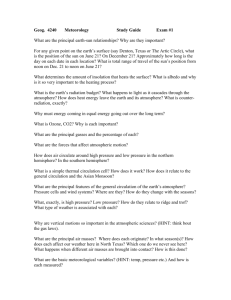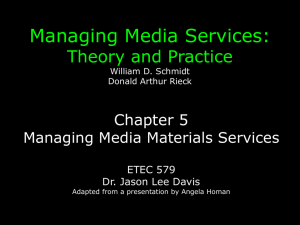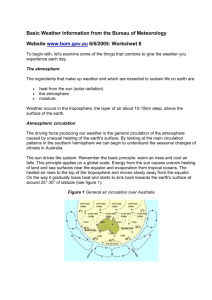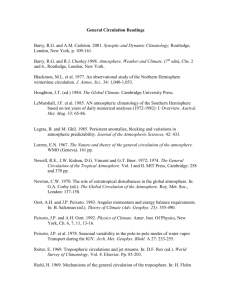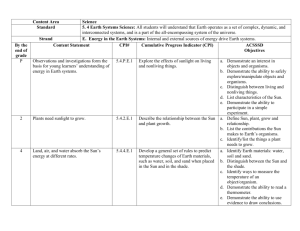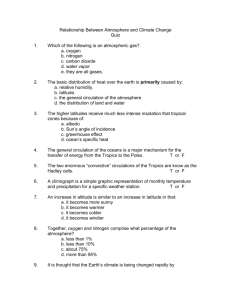09_AtmosphericCirculation
advertisement
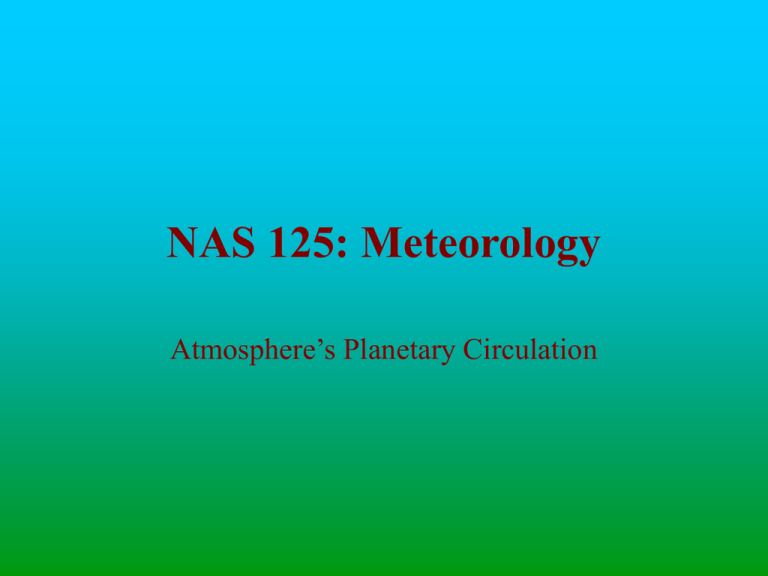
NAS 125: Meteorology Atmosphere’s Planetary Circulation El Niño, part 1 • Global weather went wild in 1982-1983. – Crippling droughts struck Australia, India, Indonesia, the Philippines, Mexico, Central America, and southern Africa. • Huge drought-related wildfires raged across Australia and Borneo. • Australia’s worst drought in 200 years caused $2 billion in crop damage. – Floods devastated parts of western and southeastern United States, Cuba, and northwestern South America. – Destructive tropical cyclones lashed French Polynesia and Hawai’i. Rev. 6 April 2006 Atmosphere’s Planetary Circulation 2 El Niño, part 2 • Weather gone wild (continued): – Abnormally warm waters over a 13,000-km stretch of the equatorial Pacific caused massive dieoffs of fish, seabirds, marine mammals, and corals. • Collapse of plankton population led to a collapse of the anchovy population, which in turn led to a collapse of other fish populations, which in turn led to a collapse of seabird and marine mammal populations. • Adult seabirds abandoned their young on Kiribati. – In all, the weather-related events, called “the most disastrous in recorded history,” cost 2000 human lives, about $13 billion in damage, and vast ecological havoc). Rev. 6 April 2006 Atmosphere’s Planetary Circulation 3 El Niño, part 3 • The cause of the disaster was an unusual warming of surface waters in the eastern equatorial Pacific off the coast of Ecuador and Peru. • Residents of the area had known about the weather pattern caused by the warming for some time, and called it El Niño. – The rest of the world knew about it after 1982-1983. Rev. 6 April 2006 Atmosphere’s Planetary Circulation 4 General circulation, part 1 • According to an idealized circulation pattern (on a non-rotating earth with a uniform surface), unequal heating would create a two-cell circulation pattern. – The cells, one in each hemisphere, would have rising air at the equator and descending air at the poles. – Winds at the surface would blow from the poles toward the equator, and winds aloft would blow from the equator toward the poles. • The rotation of the Earth and its variable surfaces create a complex atmospheric circulation pattern. Rev. 6 April 2006 Atmosphere’s Planetary Circulation 5 General circulation, part 2 • Only the tropical regions have complete vertical circulation cells, called Hadley cells. – In a Hadley cell, heating at the equator warms the air above, causing it to rise to elevations of about 15 km, where it cools, moves poleward, then subsides. The air descends at roughly 30° north or south latitude. – There are two Hadley cells. • Outside the tropical and subtropical latitudes, vertical cells do not exist or are weakly and sporadically developed. Rev. 6 April 2006 Atmosphere’s Planetary Circulation 6 Rev. 6 April 2006 Atmosphere’s Planetary Circulation 7 General circulation, part 3 • Global pressure patterns drive global wind patterns. • The patterns observed migrate north and south with the patterns of solar heating produced as the Earth orbits the sun. – The north-south migration of climate patterns is enhanced over the continents and reduced over the oceans. Rev. 6 April 2006 Atmosphere’s Planetary Circulation 8 Rev. 6 April 2006 Atmosphere’s Planetary Circulation 9 Rev. 6 April 2006 Atmosphere’s Planetary Circulation 10 Rev. 6 April 2006 Atmosphere’s Planetary Circulation 11 General circulation, part 4 • The general circulation of the atmosphere has seven surface components: – – – – – – – Subtropical highs Intertropical convergence zone Polar highs Subpolar lows Trade winds Midlatitide westerlies Polar easterlies Rev. 6 April 2006 Atmosphere’s Planetary Circulation 12 Rev. 6 April 2006 Atmosphere’s Planetary Circulation 13 General circulation, part 5 • Subtropical highs – The subtropical latitudes serve as the “source” of the major surface winds of the planet. – The subtropical highs (STHs) are large semipermanent anticyclones centered at about 30° latitude over the oceans – Their average diameter is about 3,200 kilometers. – They develop from the descending limbs of Hadley cells. – The location of the subtropical highs are coincident with most of the world’s major desert belts. – Migration of the anticyclones affects weather of midlatitudes. Rev. 6 April 2006 Atmosphere’s Planetary Circulation 14 Rev. 6 April 2006 Atmosphere’s Planetary Circulation 15 General circulation, part 6 • Subtropical highs (continued) – The Horse latitudes are areas in the subtropical highs characterized by warm, tropical sunshine and an absence of wind. • They exist because the weather within a subtropical high is nearly always clear, warm, and calm. – The subtropical highs serve as source for two of the world’s three major surface systems: • Trade winds • Westerlies Rev. 6 April 2006 Atmosphere’s Planetary Circulation 16 General circulation, part 7 • Intertropical convergence zone – The intertropical convergence zone (ITCZ) is a belt of calm air where the northeast trades and southeast trades converge, generally in the vicinity of the equator (or at least the heat equator). • The zone is also called the equatorial front, the intertropical front, and the doldrums. • Intertropical convergence zone thunderstorms provide the updrafts where all the rising air in of the tropics ascends. • The zone often appears as a narrow band of clouds over oceans, but it is less distinct over continents. Rev. 6 April 2006 Atmosphere’s Planetary Circulation 17 General circulation, part 8 • Polar highs – The polar highs are anticyclones centered over the polar regions. • The Antarctic high is quite different from the Arctic high because it forms over an extensive, high-elevation, and very cold continent, while the Artic high forms primarily over sea ice. • The Antarctic high is strong, persistent, and almost permanent, while the Arctic high is much less pronounced and more ephemeral. • The polar highs are the source of the polar easterlies, which blow toward the equator and toward (not from) the west. Rev. 6 April 2006 Atmosphere’s Planetary Circulation 18 General circulation, part 9 • Subpolar lows – The subpolar lows are a zone of low pressure situated at about 50° to 60° of latitude in both the Northern and Southern hemispheres. • They often contain the polar front. • The characteristics vary in either hemisphere because the continents modify circulation in the Northern hemisphere, while circulation in the Southern hemisphere is over a virtually continuous expanse of ocean, the Southern Ocean. • The polar front is the meeting ground of the cold polar easterlies and the warm midlatitude westerlies, and is the site of genesis of many midlatitude weatehr systems. Rev. 6 April 2006 Atmosphere’s Planetary Circulation 19 General circulation, part 10 • Trade winds – The trade winds are the major wind system of the tropics, originating from the equatorward sides of the subtropical highs and blowing toward the west as well toward the equator. – The trades are the most reliable of all winds in terms of both direction and speed. – They are named for the direction they blow from. • In the Northern Hemisphere, they blow from the northeast, so are called the northeast trades. • In the Southern Hemisphere, they blow from the southeast, so are called the southeast trades. Rev. 6 April 2006 Atmosphere’s Planetary Circulation 20 General circulation, part 11 • Trade winds (continued) – The trades are warming, drying winds, but are capable of holding enormous amounts of moisture. • They generally do not release moisture unless forced by a topographic barrier or a pressure disturbance. – The winds typically pass over low-lying islands, drying them of moisture and turning them into desert islands. – On the other hand, windward slopes exposed to the trades, as in the mountains of Hawai’i, are some of the wettest places on Earth. Rev. 6 April 2006 Atmosphere’s Planetary Circulation 21 General circulation, part 12 • Midlatitude westerlies – The westerlies are the great wind system of the midlatitudes, flowing from west to east around the world in a latitudinal zone between about 30° and 60˚ both north and south of the equator. – They originate from the poleward side of the subtropical highs, blowing toward the poles and toward the east. – There are two cores of high-speed winds at high altitudes in the westerlies: • Polar front jet stream • Subtropical front jet stream Rev. 6 April 2006 Atmosphere’s Planetary Circulation 22 General circulation, part 13 • Midlatitude westerlies (continued) – A major feature of the midlatitude westerlies are the Rossby waves, sweeping north-south undulations that frequently develop aloft. • The undulating motion of the Rossby waves, coupled with the migratory pressure systems and storms associated with the westerlies, give the middle latitudes more short-run weather variability than any other place on Earth. • Anticyclonic circulation at the surface is associated with ridges in the waves, while cyclonic circulation is associated with troughs in the waves. Rev. 6 April 2006 Atmosphere’s Planetary Circulation 23 Rev. 6 April 2006 Atmosphere’s Planetary Circulation 24 General circulation, part 14 • Polar easterlies – The polar easterlies are a global wind system that occupies most of the area between the polar highs and about 60° of latitude. • The winds move generally from east to west and are typically cold and dry. Rev. 6 April 2006 Atmosphere’s Planetary Circulation 25 General circulation, part 15 • Vertical patterns of the general circulation – Winds in the upper elevations of troposphere differ from surface winds. • The most dramatic difference occurs between surface trade winds and the upper-elevation antitrade winds. • Antitrade winds are tropical upper air winds that blow toward the northeast in the Northern Hemisphere and toward the southeast in the Southern Hemisphere. Rev. 6 April 2006 Atmosphere’s Planetary Circulation 26 Rev. 6 April 2006 Atmosphere’s Planetary Circulation 27 General circulation, part 16 • Vertical patterns (continued): – Trade wind inversion • Forms over tropical and subtropical oceans • The air just over the surface forms the marine boundary layer. • Air subsiding in the descending limb of the Hadley circulation undergoes compressional warming. • Where the descending air meets the marine boundary layer, a temperature inversion, in which the upper air is warmer than the lower air; this is the trade wind inversion. • The air in the trade wind inversion is very stable, as the inversion acts as a cap over the vertical movement of air, thus the convective development of clouds and precipitation. – It also limits orographic precipitation. Rev. 6 April 2006 Atmosphere’s Planetary Circulation 28 Rev. 6 April 2006 Atmosphere’s Planetary Circulation 29 Monsoons, part 1 • A monsoon is a seasonal reversal of winds; a general onshore movement in summer and a general offshore flow in winter, with a very distinctive seasonal precipitation regime. • Monsoons are the most significant disturbance to the pattern of general circulation. – Offshore flow is wind movement from land to water. – Onshore flow is wind movement from water to land. Rev. 6 April 2006 Atmosphere’s Planetary Circulation 30 Monsoons, part 2 • Monsoons control the climates of regions with more than half of the world’s population. • The origin of monsoons is still not understood, though there is increasing evidence that it is associated with upper-air phenomena, particularly jet stream behavior. • Monsoons have an essential effect: Their failure or even the late arrival of monsoonal moisture inevitably causes widespread starvation and economic disaster. Rev. 6 April 2006 Atmosphere’s Planetary Circulation 31 Rev. 6 April 2006 Atmosphere’s Planetary Circulation 32 Rev. 6 April 2006 Atmosphere’s Planetary Circulation 33 Rossby waves, part 1 • The Rossby waves were first described by Carl Gustav Rossby in the 1930s. • In the waves, winds exhibit anticyclonic flow in the ridges, and cyclonic flow in the troughs. • Typically, there are two to five waves in a hemisphere at any given time. • Wave characteristics: – Wavelength – Amplitude – Wave number Rev. 6 April 2006 Atmosphere’s Planetary Circulation 34 Rossby waves, part 2 • Types of flow in Rossby waves: – There is a north-south, or meridional, component; and an east-west, or zonal component. – Zonal flow occurs when there is a minimal north-south component (minimal amplitude) in the Rossby waves. – Meridional flow occurs when there is a considerable northsouth component (considerable amplitude) in the Rossby waves. – In split flow, the wave configuration westerlies to the north differs from the configuration of those to the south. – There is no predictable flow cycle. Rev. 6 April 2006 Atmosphere’s Planetary Circulation 35 Rev. 6 April 2006 Atmosphere’s Planetary Circulation 36 Rev. 6 April 2006 Atmosphere’s Planetary Circulation 37 Rev. 6 April 2006 Atmosphere’s Planetary Circulation 38 Rossby waves, part 3 • Blocking systems: – When Rossby circulation over North America is strongly meridional, whirling masses of air separate from the main westerly flow. – Such cutoff air may prevent the usual east-west flow of the westerlies, thus setting up blocking systems. • These blocking systems are often responsible for extreme weather patterns in the United States. – 1986 drought in Southeast – 1988 drought in the Midwest and Great Plains – 1993 floods in the Midwest, with drought in the Southeast Rev. 6 April 2006 Atmosphere’s Planetary Circulation 39 Rev. 6 April 2006 Atmosphere’s Planetary Circulation 40 Rev. 6 April 2006 Atmosphere’s Planetary Circulation 41 Rev. 6 April 2006 Atmosphere’s Planetary Circulation 42 Rev. 6 April 2006 Atmosphere’s Planetary Circulation 43 Rev. 6 April 2006 Atmosphere’s Planetary Circulation 44 Rossby waves, part 4 • Short waves: – Short waves are ripples superimposed on the Rossby waves. • Short waves travel much more quickly than Rossby waves. • Short waves are more numerous than Rossby waves. – Short waves and Rossby waves both contribute to cyclone development in the midlatitudes. • Westerly winds strengthen in ridges and weaken in troughs, leading to divergence in the middle and upper troposphere east of a trough (and west of a ridge). Rev. 6 April 2006 Atmosphere’s Planetary Circulation 45 Rev. 6 April 2006 Atmosphere’s Planetary Circulation 46 Rev. 6 April 2006 Atmosphere’s Planetary Circulation 47 Jet streams, part 1 • Jet streams are narrow corridors of very strong winds. • The most prominent in the Northern Hemisphere is the polar front jet stream, above the polar front in the upper troposphere. – Westbound flights avoid it because it is a headwind, which makes the trip take more time; while eastbound flights seek it because it is a tailwind, which makes the trip take less time. Rev. 6 April 2006 Atmosphere’s Planetary Circulation 48 Jet streams, part 2 • Jet streams are created as a result of the relationship between air temperature and density. – Cold air in the troposphere is denser than warm air, so density decreases more rapidly in a column air than in one of warm air. • At higher altitudes, pressure is greater in warm air than in cold air. – Thus, the difference in density between cold and warm air becomes greater with increasing elevation. • Thus, horizontal pressure gradients become greater with increasing elevation. • The speed of pressure gradient winds in turn increase with increasing elevation. Rev. 6 April 2006 Atmosphere’s Planetary Circulation 49 Rev. 6 April 2006 Atmosphere’s Planetary Circulation 50 Jet streams, part 3 • Jet stream creation (continued): – Because of the lack of friction, the interaction between the pressure gradient force and the Coriolis effect results in geostrophic winds, with cold air to the left of the direction of motion and warm air to the right. • Temperature gradients are reversed in the stratosphere, so the pressure and speed gradients are reversed as well. Rev. 6 April 2006 Atmosphere’s Planetary Circulation 51 Jet streams, part 4 • Jet streaks – The polar front jet stream is not uniformly well defined around the globe. – Wind speeds are greatest where the jet is best defined. – In those areas, wind speeds may increase as much as 100 km, thus forming jet streaks. – The strongest jet streaks are formed in eastern North America and Asia where there is a strong contrast in land and water temperatures. Rev. 6 April 2006 Atmosphere’s Planetary Circulation 52 Jet streams, part 4 • Jet streams help in the genesis and maintenance of synoptic-scale cyclones by contributing to divergence aloft. – Isotachs are lines of equal wind speed. – Jet streaks can be subdivided into four quadrants: upper right, lower right, upper left, and lower left. – Air accelerates as it enters a jet streak, and decelerates as it exits one. – The change in air speed generates divergence in the leftfront and right-rear quadrants, while convergence occurs in the right-front and left-rear quadrants. Rev. 6 April 2006 Atmosphere’s Planetary Circulation 53 Rev. 6 April 2006 Atmosphere’s Planetary Circulation 54 Jet streams, part 5 • Jet streaks and cyclogenesis (continued): – In general, the strongest horizontal divergence is in the leftfront quadrant for a straight jet streak or a cyclonically curved one. • This is where cyclones are more likely to form. – For an anticyclonically curved jet streak, the strongest horizontal divergence is in the right-rear quadrant. – Jet streaks typically migrate west to east more quickly than westerly troughs and ridges; the strongest divergence aloft is where a jet streak is on the east side of a trough. Rev. 6 April 2006 Atmosphere’s Planetary Circulation 55 Jet streams, part 6 • The position of the polar jet stream shift seasonally, migrating south during the winter and north during the summer. – This plays a role in the typical location of severe weather, such as tornado location. • Other jet streams include the subtropical jet, the tropical easterly jet, and a low-level jet that helps trigger nighttime thunderstorms in the Mississippi Valley. Rev. 6 April 2006 Atmosphere’s Planetary Circulation 56 Rev. 6 April 2006 Atmosphere’s Planetary Circulation 57 El Niño, part 1 • El Niño is an anomalous oceanographic-weather phenomenon of the eastern equatorial Pacific, particularly along coast of South America. – It occurs when southeastern trades abnormally slacken or reverse direction, which triggers a warm surface flow, which displace the cold, nutrient-rich upwelling that usually prevails on the surface. – Upwelling is driven by Ekman transport, in which prevailing winds parallel to the coast trigger transport of water from the depths to the surface; transport is in a spiral motion with depth referred to as an Ekman spiral. Rev. 6 April 2006 Atmosphere’s Planetary Circulation 58 Rev. 6 April 2006 Atmosphere’s Planetary Circulation 59 Rev. 6 April 2006 Atmosphere’s Planetary Circulation 60 El Niño, part 2 • El Niño (continued): – El Niño was once believed to be a local phenomenon, but is now understood to be associated with changes in global pressure, wind, and precipitation. – It occurs every few years around Christmas time (El Niño is Spanish for “the Christ child”). – Even though archeological and paleoclimatological records have indicated past El Niño phenomenon, it was not until 1982–1983 that great attention was drawn to it. Rev. 6 April 2006 Atmosphere’s Planetary Circulation 61 Rev. 6 April 2006 Atmosphere’s Planetary Circulation 62 El Niño, part 3 • Normal pattern: In order to understand El Niño phenomenon, it is critical to understand normal pressure, wind, and ocean current patterns in the Pacific. – Dominance of the subtropical high in the eastern Pacific causes westward movement of the trade winds toward low pressure cell in the western Pacific. • Trade winds create frictional drag on the Pacific Ocean and create westward moving warm equatorial current. • The removal of surface water near the western coast of South America allows cold water to upwell. Rev. 6 April 2006 Atmosphere’s Planetary Circulation 63 El Niño, part 4 • Normal pattern (continued): – This phenomenon is known as the Southern Oscillation, a large-scale fluctuation in sea-level atmospheric pressure that occasionally occurs in the eastern and western tropical Pacific; caused by differences in water temperature. • When El Niño and Southern Oscillation coincide (called ENSO), unusual atmospheric and oceanic conditions are more frequent and more intense than when either event occurs alone. Rev. 6 April 2006 Atmosphere’s Planetary Circulation 64 El Niño, part 5 • El Niño pattern: Every few years the normal pressure pattern changes. – High pressure develops over northern Australia, and low pressure develops to the east over Tahiti. – The pressure reversal causes the trade winds to reverse direction, and this allows warm water from the western Pacific to “backwash” toward the eastern Pacific. Rev. 6 April 2006 Atmosphere’s Planetary Circulation 65 El Niño, part 6 • El Niño pattern (continued): – For many months before the onset of El Niño, the trade winds pile up warm water in the western Pacific, and then a bulge of warm equatorial water about 25 cm high moves eastward in a series of bulges known as Kelvin waves. • These waves can take 2-3 months to arrive off the coast of South America. • This causes the sea level to rise off the coast of South America as the warm water pools. • This impedes the upwelling of cold water off of the coast, and thus causes temperatures off the coast of South America to rise. Rev. 6 April 2006 Atmosphere’s Planetary Circulation 66 El Niño, part 7 • El Niño pattern (continued): – The shift in the normal pressure pattern in the Pacific can cause increased precipitation in the deserts of Peru, droughts in northern Australia and Indonesia, decreased monsoon activity in South Asia, and more powerful winter storms in the southwestern United States. Rev. 6 April 2006 Atmosphere’s Planetary Circulation 67 Rev. 6 April 2006 Atmosphere’s Planetary Circulation 68 El Niño, part 8 • La Niña: Unusually cold temperatures in the eastern Equatorial Pacific. – Both El Niño and La Niña are extreme cases of a naturally occurring climate cycle that involves large-scale changes in sea-surface temperatures across the eastern tropical Pacific. – La Niña is not as predictable as El Niño. Rev. 6 April 2006 Atmosphere’s Planetary Circulation 69 El Niño, part 9 • Causes of ENSO – There is no clear “trigger” of ENSO. It is not clear whether the changes in the ocean temperature or the changes in the pressure and wind occur first. – The effects of ENSO are also not completely predictable. • Some generalizations, however, can be made (i.e., floods are more likely to occur in California during El Niño years). – There is increasing recognition of El Niño connections with atmospheric and oceanic conditions outside of the Pacific. • These connections are known as teleconnections. Rev. 6 April 2006 Atmosphere’s Planetary Circulation 70 El Niño, part 10 • Causes of ENSO (continued): – ENSO may be influenced by other ocean-atmosphere cycles such as the North Atlantic Oscillation and the Pacific Decadal Oscillation. – Deployed instrument buoys (the Tropical Atmosphere/Ocean Array) are now used to monitor El Niño and aid in making climatic predictions. Rev. 6 April 2006 Atmosphere’s Planetary Circulation 71 El Niño, part 11 • El Niños are becoming more frequent and progressively warmer in recent years. – The 1997-98 El Niño was the strongest in history, and it developed more rapidly than any other in the last 40 years. • The triggering mechanisms are still unclear. Rev. 6 April 2006 Atmosphere’s Planetary Circulation 72 Rev. 6 April 2006 Atmosphere’s Planetary Circulation 73
